Team Typha
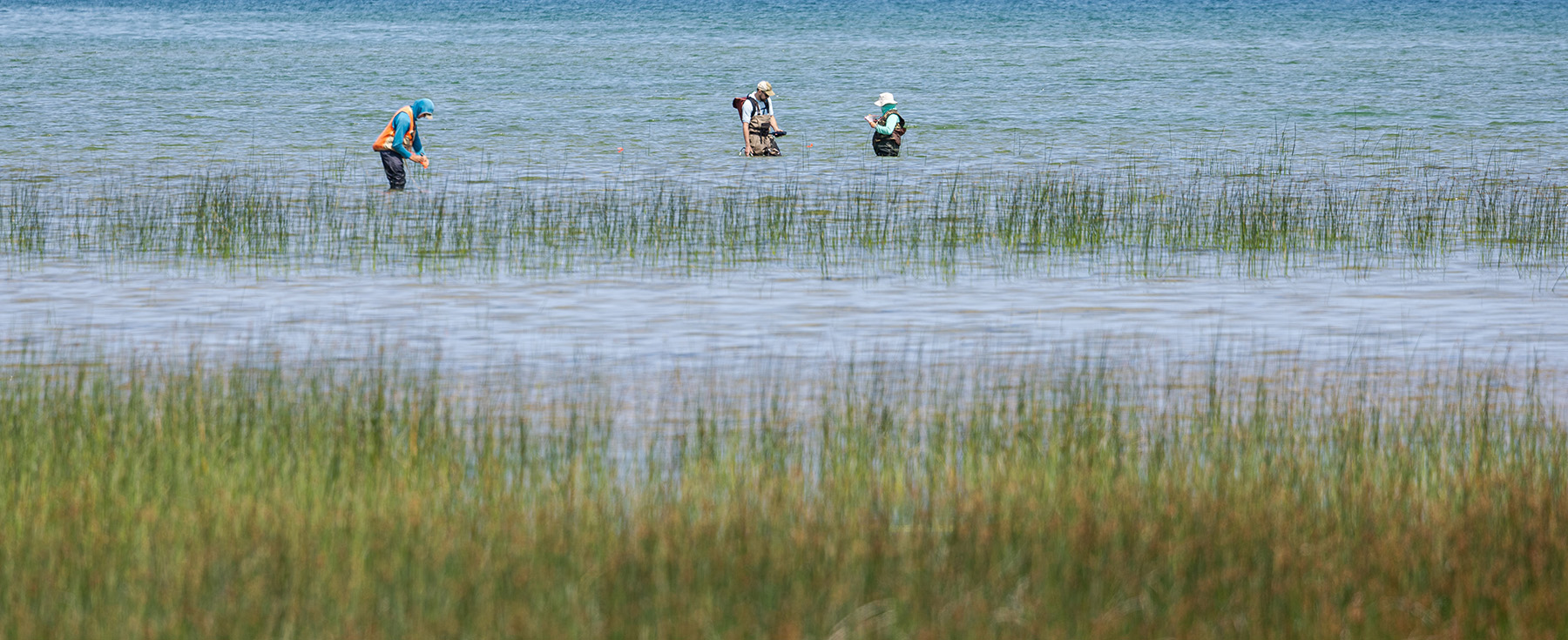
Restoring Biodiverse Wetlands in the Great Lakes Region
At the northern tip of Michigan’s lower peninsula, researchers from Loyola University Chicago’s School of Environmental Sustainability are devising new methods of restoring biologically diverse wetlands.
Assistant Professor Brian Ohsowski, PhD, and Research Associate Shane Lishawa, MS, lead Team Typha, a research group focused on combatting invasive plants that disrupt wetland ecosystems and crowd out native species. The researchers aim to develop a scalable management strategy to restore high-quality habitats for birds, fish, and other wildlife. They recently secured more than $1.1 million in federal funding for a large-scale project that could inform wetland management practices throughout the Great Lakes region.
The project, funded through the Great Lakes Restoration Initiative (GLRI), is the latest development in work that started more than 20 years ago. At that time, Nancy Tuchman, PhD, founding dean of SES, was an associate professor in Loyola’s biology department. Tuchman led a research team based at the University of Michigan Biological Station in northern Michigan, 24 miles south of the Mackinac Bridge. She and her master’s degree students had noticed that a new, aggressive cattail hybrid was taking over nearby Cheboygan Marsh.
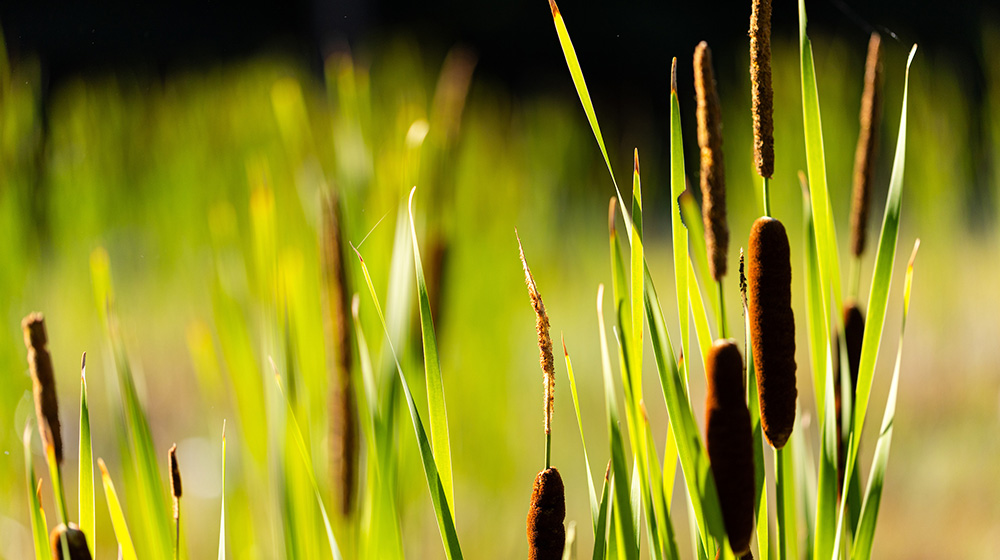
Invasive cattails outcompete native species and disrupt wetland ecosystems throughout the Great Lakes region.
Typha × glauca (Typha) is a cross between a non-native cattail and a native species. The hybrid plant tolerates a wide range of conditions and grows fast in the spring, getting a head start on other plants thanks to its strategy of storing nutrients in its underground stems called rhizomes. Dense stands of the large cattails, reaching more than 10 feet tall, can quickly dominate a marsh ecosystem, eliminate stretches of open water, and reduce wetland biodiversity.
Typha also leaves a tremendous amount of leaf litter in wetlands, which builds up over the years. Tuchman’s research revealed that the accumulating biomass was driving changes in the physical structure of wetlands to the detriment of native plants and animals.
Both Lishawa and Ohsowski first met Tuchman and learned about her research when they were working and studying at the Michigan Biological Station—Lishawa in 1999 when he was an undergraduate at the University of Michigan, and Ohsowski in 2005 as a graduate student at Eastern Michigan University.
Lishawa went on to earn his master’s degree in forest ecology from the University of Vermont. In 2007, Tuchman hired him to help launch Loyola’s biodiesel lab. A year later, he jumped at the opportunity to return to the field in Michigan as a Loyola research associate. He continued the line of wetland research that Tuchman had started, and the work has grown ever since.
Building on Tuchman’s research on how Typha becomes dominant, Lishawa started exploring management strategies. He conducted a small-scale experiment removing cattails and leaf litter in randomly selected one-meter-square plots in a Typha-dominated wetland.
“A year later, we came back and looked at the response in the plots, and we found a bunch of native plants sprouting. So that was really encouraging, but it was super small scale,” said Lishawa.
That initial research provided the data needed to win funding for more extensive experiments. In 2010, Lishawa and Tuchman received the team’s first GLRI grant. With that support, they ran tests at multiple sites and experimented with several techniques for battling invasive cattails. In one approach, the team removed the entire Typha plant, including the below-ground rhizomes. This method produced dramatic results.
“It was just amazing,” said Lishawa. “The first time I went into one of these plots—and the water level happened to be good for seed germination with just moist soil—we had a garden of native plants sprouting from this place where we’d removed the cattails.”
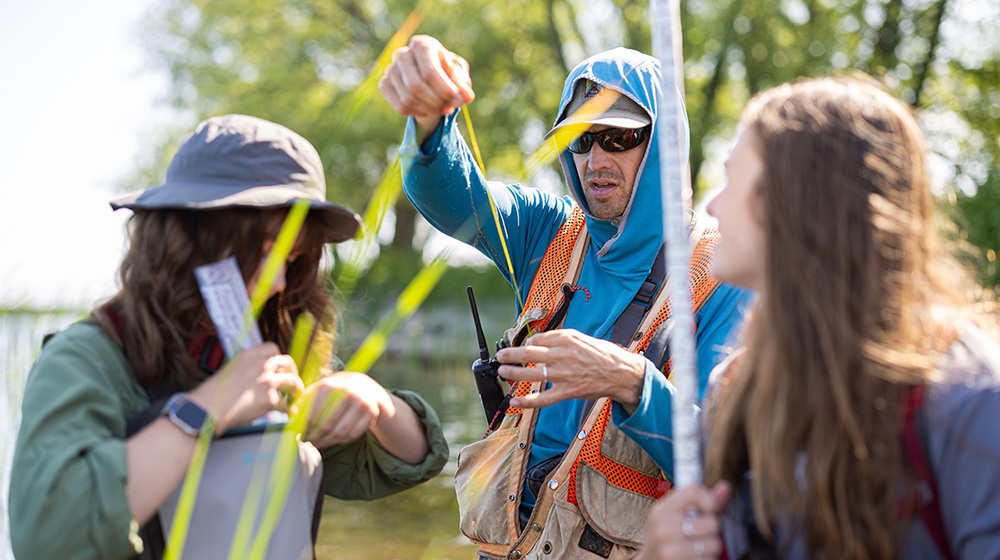
Shane Lishawa (center) is developing strategies to manage invasive cattails and restore wetland biodiversity.
Results from these first large-scale studies led to a second Lishawa and Tuchman GLRI grant in 2013. With this grant, they bought a mechanical harvester and experimented with cutting the cattails above the water level in 60-by-60-meter plots. This approach was less effective than physically removing the entire plant, including the underground rhizome. However, digging up the rhizomes was prohibitively labor-intensive, so they tried another strategy.
“We bought another piece of equipment that allowed us to cut below the water level, which is really effective at killing cattails,” said Lishawa. “Essentially, the rhizomes require oxygen to survive and respire, and so if you cut off the tissue below the water, it drowns these rhizomes.”
Over several years, the researchers tested the strategy of cutting Typha below the water level. They determined that this method was effective in restoring plant diversity, and because they used a mechanical harvester, it had the potential for large-scale application.
At this stage, Lishawa connected with Eric Dunton from the U.S. Fish and Wildlife Service (FWS). Dunton is the wildlife biologist for the Shiawassee National Wildlife Refuge, located near Saginaw, Michigan. In collaboration with Dunton, Team Typha tried below-water cutting in sections of Shiawassee dominated by invasive cattails and studied how the native plants responded. The study confirmed that native plants returned, and it showed additional benefits related to birds.
“The cool angle that connected to birds directly in that site was that we quantified the food value of the plants that came up,” said Lishawa. “We translated our plant data into bird nutritional value, and where we cut and removed cattails, there was five to twenty times more food than in the cattails.”
The work and the team continued to expand from there. Ohsowski joined the Loyola faculty in 2015 after completing a PhD in biology at the University of British Columbia. He and Lishawa soon joined forces as leaders of Team Typha. Since then, the team has won additional funding and further increased the scope and scale of their research, with each project informing the next stage of the investigations and supporting their case for further grants.
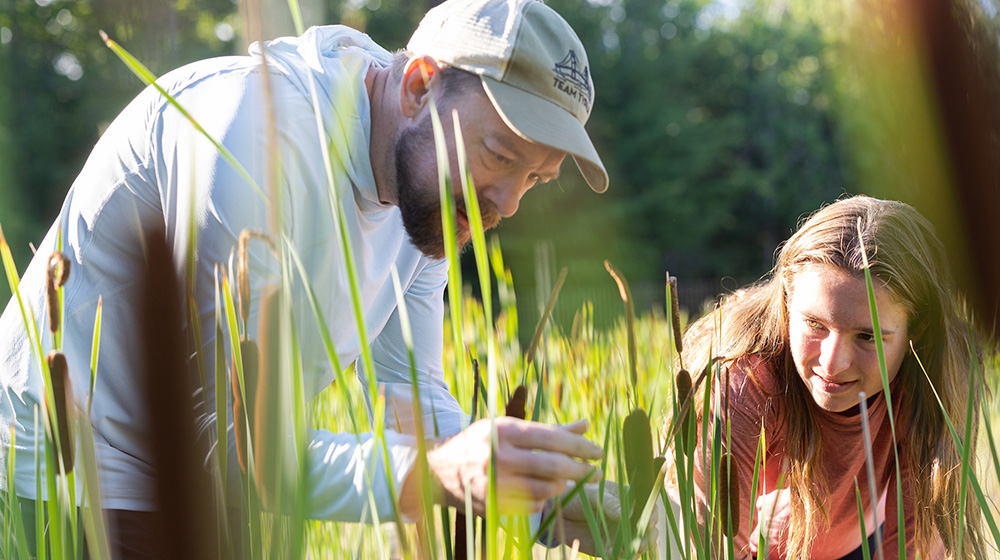
Brian Ohsowski (left) leads Team Typha along with Shane Lishawa. Training future researchers is a core component of his work.
With their increasing funding, Team Typha brought on more collaborators, hired more student research assistants, and purchased equipment that allows for larger projects. They launched more collaborations with Dunton, who was concerned with restoring habitat quality for wildlife.
“The Fish and Wildlife Service is very interested in bird diversity and migratory waterfowl, which are completely driven by habitat and vegetation structure,” said Ohsowski. “So if you have these aggressive cattails that are very dense, that can exclude marsh birds that would normally be in a more diverse, semi-open wetland where they can have some cover but also some open water and where they can find food.”
As the scale of the work grew, the team confronted another challenge—what to do with all the plant material they collected while cutting the cattails. They started looking for beneficial uses for that biomass. They tried applying it to farm fields, pelletizing it for combustion, and converting it to fuel using anaerobic digestion. Unfortunately, these approaches were not cost-effective and involved transporting the plant material long distances.
Ohsowski proposed a new approach with the potential to improve water quality, capture carbon, eliminate transportation costs and emissions, and close the loop on the restoration process. He suggested converting the harvested biomass into biochar and returning the biochar to the wetland.
Biochar is a charcoal-like substance produced by heating organic materials in an oxygen-free environment. Without oxygen, the material burns clean and forms a carbon-rich final product rather than releasing carbon into the atmosphere. The resulting biochar is known to chemically bind vital plant nutrients such as nitrates and phosphates, a quality that could be valuable for reducing the spread of Typha invasions.
Runoff from farm fields increases nutrient availability in wetlands, creating conditions ideal for fast-growing, nutrient-hungry Typha. Applying biochar to invaded wetlands could reduce nutrient availability and improve water quality for native plants that thrive under less nutrient-rich conditions. Team Typha has done small-scale projects using biochar in wetlands, and the results have been promising.
In addition to its potential for restoring biodiversity, this approach has advantages related to climate change. Biochar is a carbon-rich material that is resistant to microbial and physical breakdown in soil for hundreds of years. Furthermore, it is possible to make biochar from harvested Typha on location, cutting transportation-related emissions.
All of this research comes together in Team Typha’s latest project. This summer, they learned they will receive over $1.1 million in GLRI funding to launch a large-scale experiment at the Shiawassee National Wildlife Refuge.
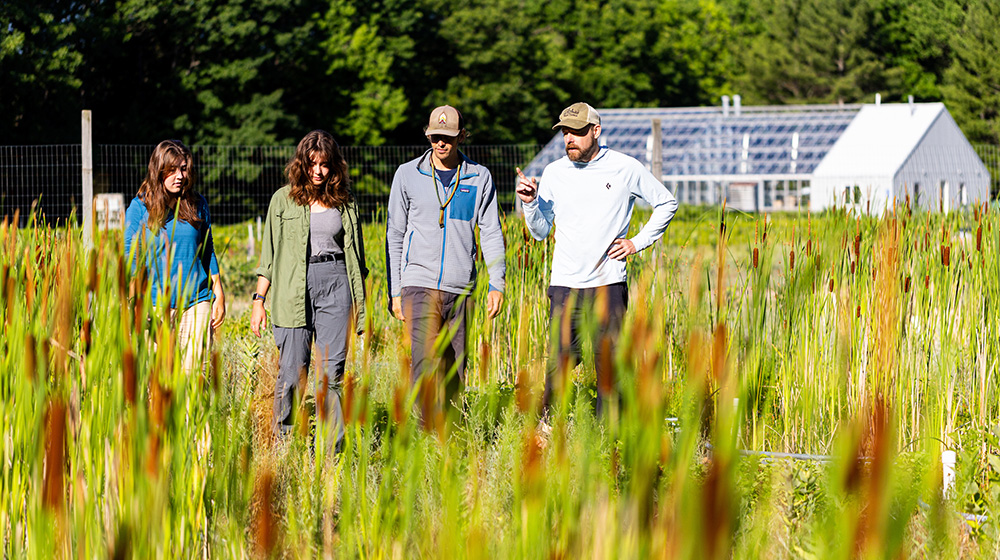
Lishawa and Ohsowski (third and fourth from the left) brought a team of 10 to the University of Michigan Biological Research Station during the summer of 2023.
The research team will harvest Typha in large sections of the refuge, convert the cut plant material into biochar on-site, and apply it to the wetlands to test the possible benefits. They plan to test Typha harvesting and biochar treatments separately and in various combinations in large plots to learn which method or combination of methods works best. Because Shiawassee is a former agricultural site, the team will also seed native plants to help restore biodiversity.
The researchers will test the results over multiple years and take what they learn to the practitioners who manage wetland habitats throughout the Great Lakes region. The large size of the project will help demonstrate that their management techniques can work in the long term and at scale.
“Large-scale ecological restoration experiments are essential for land managers and government agencies to have a visualized proof of concept. With fifty-six 1.25 acre plots to test cattail harvesting frequency and biochar application, we are pushing the limits of fully replicated field-based experiments,” said Ohsowski.
The years of work illustrate the iterative nature of scientific research. Each investigation produces new knowledge and raises further questions as the scientists develop an increasingly complete understanding of the problem and possible solutions.
“At every stage, we’re taking the data that we generate through our studies, and that’s what we’re looking at to guide the long-term vision,” said Lishawa. “That vision is to come up with a management approach for this invasive species and figure out a way for that to occur across this huge landscape effectively and sustainably.”
Ohsowski and Lishawa stress that education is also central to their work.
“A big part of our research program involves training future scientists,” said Ohsowski. “And we have a long cavalcade of undergraduate and master’s students who have helped to develop some of these research questions.”
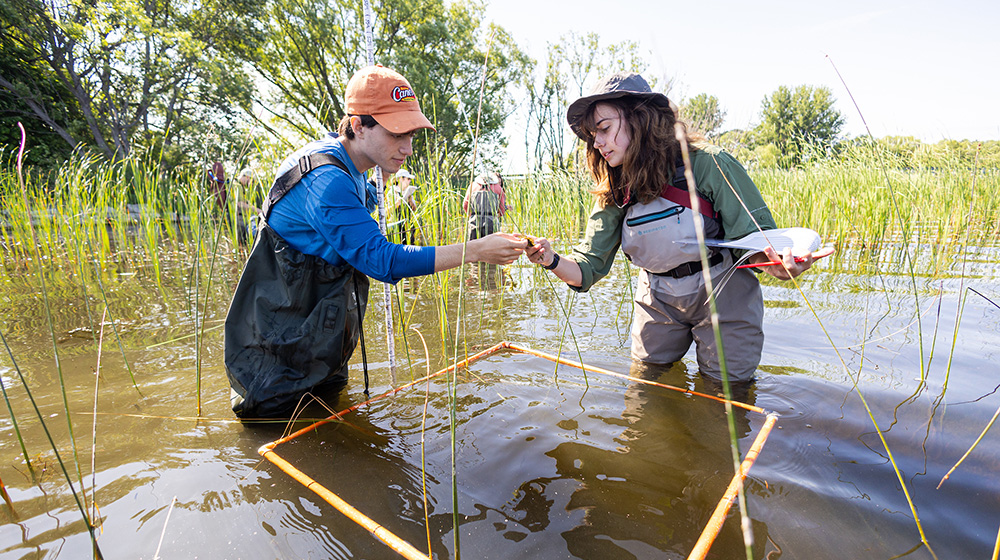
Students like Alex Risdal (right) develop valuable research skills while working with Team Typha.
Student research assistants support fieldwork and help in the lab on campus. However, the primary reason for involving students is to provide a rich learning experience. Students working with Team Typha develop valuable research skills and gain hands-on experience, and the faculty members encourage them to pursue independent projects.
“Each of these students, we take them on for a full year. We have a lab group, and it’s really like a mini master’s degree. They’re taking an idea from the proposal stage through data collection and analysis to a final product. And the scale of their projects is not tiny,” said Lishawa. “They’re coming out of their undergraduate with a very complete research experience."
During the summer of 2023, Ohsowski and Lishawa brought a team of 10 people to the research station in Michigan, including undergraduate and graduate students, research associate Sam Schurkamp, and research technician Mackenzie Michaels.
Rising sophomore Alex Risdal said her time in Michigan with Team Typha has helped crystalize her interests and career plans.
“We’ve done a lot of field botany, identifying plants, learning their names, learning their structures,” she said. “That’s really enjoyable, and I’ve realized that’s what I want to do. I want to learn all I can about each of these plants and exactly what they need.”
Risdal said she plans to pursue graduate-level education and envisions a career in botany.
For Ohsowski, the best part of the job is seeing students grow, develop as scientists, and discover work that brings them joy and meaning. He says the fieldwork in Michigan fosters these types of learning experiences.
“The students here, everyone in the field today, they were covered in mud,” he said. “They drew on their faces with mud, and they all had these ridiculous cackling laughs and big smiles. And I thought, you’re finding your calling.”
Team Typha has a big job ahead with the Shiawassee research project, but everyone involved is looking forward to the challenge. They anticipate generating new knowledge to inform regional restoration practices, and Ohsowski and Lishawa look forward to helping to launch the careers of future generations of researchers and environmental leaders.
The project, funded through the Great Lakes Restoration Initiative (GLRI), is the latest development in work that started more than 20 years ago. At that time, Nancy Tuchman, PhD, founding dean of SES, was an associate professor in Loyola’s biology department. Tuchman led a research team based at the University of Michigan Biological Station in northern Michigan, 24 miles south of the Mackinac Bridge. She and her master’s degree students had noticed that a new, aggressive cattail hybrid was taking over nearby Cheboygan Marsh.
Typha × glauca (Typha) is a cross between a non-native cattail and a native species. The hybrid plant tolerates a wide range of conditions and grows fast in the spring, getting a head start on other plants thanks to its strategy of storing nutrients in its underground stems called rhizomes. Dense stands of the large cattails, reaching more than 10 feet tall, can quickly dominate a marsh ecosystem, eliminate stretches of open water, and reduce wetland biodiversity.
Typha also leaves a tremendous amount of leaf litter in wetlands, which builds up over the years. Tuchman’s research revealed that the accumulating biomass was driving changes in the physical structure of wetlands to the detriment of native plants and animals.
Both Lishawa and Ohsowski first met Tuchman and learned about her research when they were working and studying at the Michigan Biological Station—Lishawa in 1999 when he was an undergraduate at the University of Michigan, and Ohsowski in 2005 as a graduate student at Eastern Michigan University.
Lishawa went on to earn his master’s degree in forest ecology from the University of Vermont. In 2007, Tuchman hired him to help launch Loyola’s biodiesel lab. A year later, he jumped at the opportunity to return to the field in Michigan as a Loyola research associate. He continued the line of wetland research that Tuchman had started, and the work has grown ever since.
Building on Tuchman’s research on how Typha becomes dominant, Lishawa started exploring management strategies. He conducted a small-scale experiment removing cattails and leaf litter in randomly selected one-meter-square plots in a Typha-dominated wetland.
“A year later, we came back and looked at the response in the plots, and we found a bunch of native plants sprouting. So that was really encouraging, but it was super small scale,” said Lishawa.
That initial research provided the data needed to win funding for more extensive experiments. In 2010, Lishawa and Tuchman received the team’s first GLRI grant. With that support, they ran tests at multiple sites and experimented with several techniques for battling invasive cattails. In one approach, the team removed the entire Typha plant, including the below-ground rhizomes. This method produced dramatic results.
“It was just amazing,” said Lishawa. “The first time I went into one of these plots—and the water level happened to be good for seed germination with just moist soil—we had a garden of native plants sprouting from this place where we’d removed the cattails.”
Results from these first large-scale studies led to a second Lishawa and Tuchman GLRI grant in 2013. With this grant, they bought a mechanical harvester and experimented with cutting the cattails above the water level in 60-by-60-meter plots. This approach was less effective than physically removing the entire plant, including the underground rhizome. However, digging up the rhizomes was prohibitively labor-intensive, so they tried another strategy.
“We bought another piece of equipment that allowed us to cut below the water level, which is really effective at killing cattails,” said Lishawa. “Essentially, the rhizomes require oxygen to survive and respire, and so if you cut off the tissue below the water, it drowns these rhizomes.”
Over several years, the researchers tested the strategy of cutting Typha below the water level. They determined that this method was effective in restoring plant diversity, and because they used a mechanical harvester, it had the potential for large-scale application.
At this stage, Lishawa connected with Eric Dunton from the U.S. Fish and Wildlife Service (FWS). Dunton is the wildlife biologist for the Shiawassee National Wildlife Refuge, located near Saginaw, Michigan. In collaboration with Dunton, Team Typha tried below-water cutting in sections of Shiawassee dominated by invasive cattails and studied how the native plants responded. The study confirmed that native plants returned, and it showed additional benefits related to birds.
“The cool angle that connected to birds directly in that site was that we quantified the food value of the plants that came up,” said Lishawa. “We translated our plant data into bird nutritional value, and where we cut and removed cattails, there was five to twenty times more food than in the cattails.”
The work and the team continued to expand from there. Ohsowski joined the Loyola faculty in 2015 after completing a PhD in biology at the University of British Columbia. He and Lishawa soon joined forces as leaders of Team Typha. Since then, the team has won additional funding and further increased the scope and scale of their research, with each project informing the next stage of the investigations and supporting their case for further grants.
With their increasing funding, Team Typha brought on more collaborators, hired more student research assistants, and purchased equipment that allows for larger projects. They launched more collaborations with Dunton, who was concerned with restoring habitat quality for wildlife.
“The Fish and Wildlife Service is very interested in bird diversity and migratory waterfowl, which are completely driven by habitat and vegetation structure,” said Ohsowski. “So if you have these aggressive cattails that are very dense, that can exclude marsh birds that would normally be in a more diverse, semi-open wetland where they can have some cover but also some open water and where they can find food.”
As the scale of the work grew, the team confronted another challenge—what to do with all the plant material they collected while cutting the cattails. They started looking for beneficial uses for that biomass. They tried applying it to farm fields, pelletizing it for combustion, and converting it to fuel using anaerobic digestion. Unfortunately, these approaches were not cost-effective and involved transporting the plant material long distances.
Ohsowski proposed a new approach with the potential to improve water quality, capture carbon, eliminate transportation costs and emissions, and close the loop on the restoration process. He suggested converting the harvested biomass into biochar and returning the biochar to the wetland.
Biochar is a charcoal-like substance produced by heating organic materials in an oxygen-free environment. Without oxygen, the material burns clean and forms a carbon-rich final product rather than releasing carbon into the atmosphere. The resulting biochar is known to chemically bind vital plant nutrients such as nitrates and phosphates, a quality that could be valuable for reducing the spread of Typha invasions.
Runoff from farm fields increases nutrient availability in wetlands, creating conditions ideal for fast-growing, nutrient-hungry Typha. Applying biochar to invaded wetlands could reduce nutrient availability and improve water quality for native plants that thrive under less nutrient-rich conditions. Team Typha has done small-scale projects using biochar in wetlands, and the results have been promising.
In addition to its potential for restoring biodiversity, this approach has advantages related to climate change. Biochar is a carbon-rich material that is resistant to microbial and physical breakdown in soil for hundreds of years. Furthermore, it is possible to make biochar from harvested Typha on location, cutting transportation-related emissions.
All of this research comes together in Team Typha’s latest project. This summer, they learned they will receive over $1.1 million in GLRI funding to launch a large-scale experiment at the Shiawassee National Wildlife Refuge.
The research team will harvest Typha in large sections of the refuge, convert the cut plant material into biochar on-site, and apply it to the wetlands to test the possible benefits. They plan to test Typha harvesting and biochar treatments separately and in various combinations in large plots to learn which method or combination of methods works best. Because Shiawassee is a former agricultural site, the team will also seed native plants to help restore biodiversity.
The researchers will test the results over multiple years and take what they learn to the practitioners who manage wetland habitats throughout the Great Lakes region. The large size of the project will help demonstrate that their management techniques can work in the long term and at scale.
“Large-scale ecological restoration experiments are essential for land managers and government agencies to have a visualized proof of concept. With fifty-six 1.25 acre plots to test cattail harvesting frequency and biochar application, we are pushing the limits of fully replicated field-based experiments,” said Ohsowski.
The years of work illustrate the iterative nature of scientific research. Each investigation produces new knowledge and raises further questions as the scientists develop an increasingly complete understanding of the problem and possible solutions.
“At every stage, we’re taking the data that we generate through our studies, and that’s what we’re looking at to guide the long-term vision,” said Lishawa. “That vision is to come up with a management approach for this invasive species and figure out a way for that to occur across this huge landscape effectively and sustainably.”
Ohsowski and Lishawa stress that education is also central to their work.
“A big part of our research program involves training future scientists,” said Ohsowski. “And we have a long cavalcade of undergraduate and master’s students who have helped to develop some of these research questions.”
Student research assistants support fieldwork and help in the lab on campus. However, the primary reason for involving students is to provide a rich learning experience. Students working with Team Typha develop valuable research skills and gain hands-on experience, and the faculty members encourage them to pursue independent projects.
“Each of these students, we take them on for a full year. We have a lab group, and it’s really like a mini master’s degree. They’re taking an idea from the proposal stage through data collection and analysis to a final product. And the scale of their projects is not tiny,” said Lishawa. “They’re coming out of their undergraduate with a very complete research experience."
During the summer of 2023, Ohsowski and Lishawa brought a team of 10 people to the research station in Michigan, including undergraduate and graduate students, research associate Sam Schurkamp, and research technician Mackenzie Michaels.
Rising sophomore Alex Risdal said her time in Michigan with Team Typha has helped crystalize her interests and career plans.
“We’ve done a lot of field botany, identifying plants, learning their names, learning their structures,” she said. “That’s really enjoyable, and I’ve realized that’s what I want to do. I want to learn all I can about each of these plants and exactly what they need.”
Risdal said she plans to pursue graduate-level education and envisions a career in botany.
For Ohsowski, the best part of the job is seeing students grow, develop as scientists, and discover work that brings them joy and meaning. He says the fieldwork in Michigan fosters these types of learning experiences.
“The students here, everyone in the field today, they were covered in mud,” he said. “They drew on their faces with mud, and they all had these ridiculous cackling laughs and big smiles. And I thought, you’re finding your calling.”
Team Typha has a big job ahead with the Shiawassee research project, but everyone involved is looking forward to the challenge. They anticipate generating new knowledge to inform regional restoration practices, and Ohsowski and Lishawa look forward to helping to launch the careers of future generations of researchers and environmental leaders.
